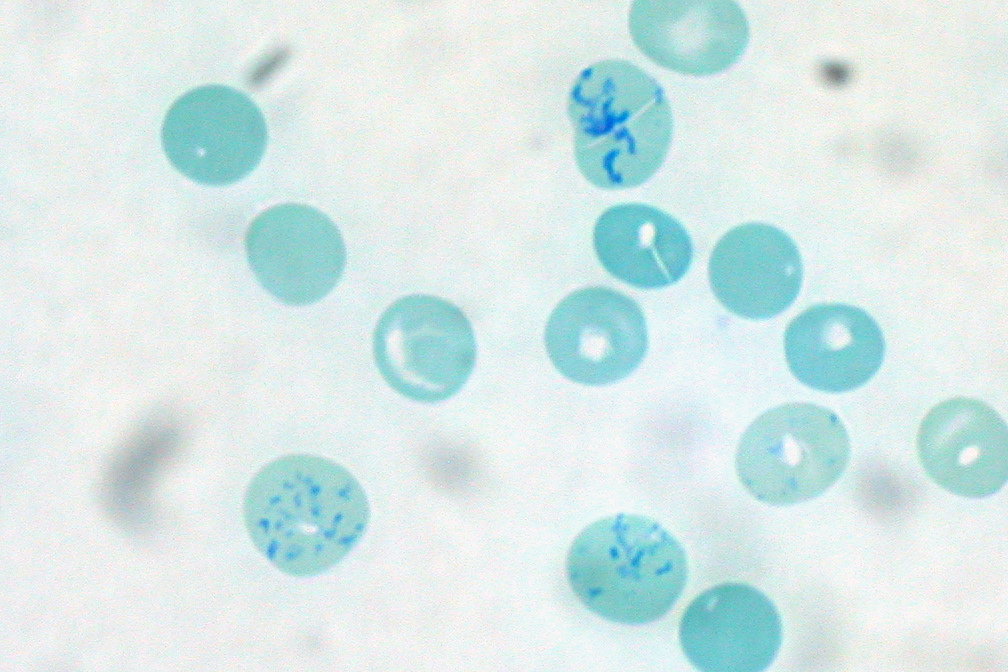|
Vaso-occlusive Crisis
A vaso-occlusive crisis is a common painful complication of sickle cell anemia in adolescents and adults. It is a form of sickle cell crisis. Sickle cell anemia – most common in those of African, Hispanic, and Mediterranean origin – leads to sickle cell crisis when the circulation of blood vessels is obstructed by sickled red blood cells, causing ischemic injuries. The most common complaint is of pain, and recurrent episodes may cause irreversible organ damage. One of the most severe forms is the acute chest syndrome which occurs as a result of infarction of the lung parenchyma. This can rapidly result in death. Other types of vaso-occlusive crisis in sickle cell anemia include dactylitis, priapism, abdominal pain, and jaundice. Diagnosis Diagnosis of vaso-occlusive crisis is based on clinical manifestations, complete blood count with white blood cell differential, platelet Platelets or thrombocytes () are a part of blood whose function (along with the coagulatio ... [...More Info...] [...Related Items...] OR: [Wikipedia] [Google] [Baidu] |
Angiology
Angiology (from Greek , ''angeīon'', "vessel"; and , ''-logia'') is the medical specialty dedicated to studying the circulatory system and of the lymphatic system, i.e., arteries, veins and lymphatic vessels. In the UK, this field is more often termed ''angiology'', and in the United States the term vascular medicine is more frequent. The field of vascular medicine (angiology) is the field that deals with preventing, diagnosing, and treating lymphatic and blood vessel related diseases. Overview Arterial diseases include the aorta ( aneurysms/dissection) and arteries supplying the legs, hands, kidneys, brain, intestines. It also covers arterial thrombosis and embolism; vasculitides; and vasospastic disorders. Naturally, it deals with preventing cardiovascular diseases such as heart attack and stroke. Venous diseases include venous thrombosis, chronic venous insufficiency, and varicose veins. Lymphatic diseases include primary and secondary forms of lymphedema. It ... [...More Info...] [...Related Items...] OR: [Wikipedia] [Google] [Baidu] |
White Blood Cell Differential
A white blood cell differential is a medical laboratory test that provides information about the types and amounts of white blood cells in a person's blood. The test, which is usually ordered as part of a complete blood count (CBC), measures the amounts of the five normal white blood cell typesneutrophils, lymphocytes, monocytes, eosinophils and basophilsas well as abnormal cell types if they are present. These results are reported as percentages and absolute values, and compared against reference ranges to determine whether the values are normal, low, or high. Changes in the amounts of white blood cells can aid in the diagnosis of many health conditions, including viral disease, viral, Pathogenic bacteria, bacterial, and parasitic disease, parasitic infections and blood disorders such as leukemia. White blood cell differentials may be performed by an automated analyzera machine designed to run laboratory tests – or manually, by examining blood smears under a microscope. The ... [...More Info...] [...Related Items...] OR: [Wikipedia] [Google] [Baidu] |
Hyperbaric Oxygen
Hyperbaric medicine is medical treatment in which an increase in barometric pressure of typically air or oxygen is used. The immediate effects include reducing the size of gas emboli and raising the partial pressures of the gases present. Initial uses were in decompression sickness, and it also effective in certain cases of gas gangrene and carbon monoxide poisoning. There are potential hazards. Injury can occur at pressures as low as 2 psig (13.8 kPa) if a person is rapidly decompressed. If oxygen is used in the hyperbaric therapy, this can increase the fire hazard. Hyperbaric oxygen therapy (HBOT), is the medical use of greater than 99% oxygen at an ambient pressure higher than atmospheric pressure, and therapeutic recompression. The equipment required consists of a pressure vessel for human occupancy (hyperbaric chamber), which may be of rigid or flexible construction, and a means of a controlled atmosphere supply. Treatment gas may be the ambient chamber gas, or delivered via ... [...More Info...] [...Related Items...] OR: [Wikipedia] [Google] [Baidu] |
Artemisinin
Artemisinin () and its semisynthetic derivatives are a group of drugs used in the treatment of malaria due to ''Plasmodium falciparum''. It was discovered in 1972 by Tu Youyou, who shared the 2015 Nobel Prize in Physiology or Medicine for her discovery. Artemisinin-based combination therapies (ACTs) are now standard treatment worldwide for ''P. falciparum'' malaria as well as malaria due to other species of ''Plasmodium''. Artemisinin can be extracted from the herb '' Artemisia annua'' (sweet wormwood), which is used in traditional Chinese medicine. Alternatively, it can be prepared by a semi-synthetic method from a precursor compound that can be produced using a genetically engineered yeast, which is much more efficient than extraction from the plant. Artemisinin and its derivatives are all sesquiterpene lactones containing an unusual peroxide bridge. This endoperoxide 1,2,4-trioxane ring is responsible for their antimalarial properties. Few other natural compounds wit ... [...More Info...] [...Related Items...] OR: [Wikipedia] [Google] [Baidu] |
Ringer's Lactate
Ringer's lactate solution (RL), also known as sodium lactate solution, Lactated Ringer's (LR), and Hartmann's solution, is a mixture of sodium chloride, sodium lactate, potassium chloride, and calcium chloride in water. It is used for replacing fluids and electrolytes in those who have low blood volume or low blood pressure. It may also be used to treat metabolic acidosis and to wash the eye following a chemical burn. It is given by intravenous infusion or applied to the affected area. Side effects may include allergic reactions, high blood potassium, hypervolemia, and high blood calcium. It may not be suitable for mixing with certain medications and some recommend against use in the same infusion as a blood transfusion. Ringer's lactate solution has a lower rate of acidosis as compared with normal saline. Use is generally safe in pregnancy and breastfeeding. Ringer's lactate solution is in the Volume expander#Crystalloids, crystalloid family of medications. It i ... [...More Info...] [...Related Items...] OR: [Wikipedia] [Google] [Baidu] |
Normal Saline
Saline (also known as saline solution) is a mixture of sodium chloride (salt) and water. It has a number of uses in medicine including cleaning wounds, removal and storage of contact lenses, and help with dry eyes. By intravenous therapy, injection into a vein, it is used to treat hypovolemia such as that from gastroenteritis and diabetic ketoacidosis. Large amounts may result in fluid overload, edema, swelling, hyperchloremic acidosis, acidosis, and high blood sodium. In those with long-standing low blood sodium, excessive use may result in osmotic demyelination syndrome. Saline is in the Volume expander#Crystalloids, crystalloid family of medications. It is most commonly used as a Sterilization (microbiology), sterile 9 g of salt per litre (0.9%) solution, known as ''normal saline''. Higher and lower concentrations may also occasionally be used. Saline is acidic, with a pH of 5.5 (due mainly to dissolved carbon dioxide). The medical use of saline began around 1831. It ... [...More Info...] [...Related Items...] OR: [Wikipedia] [Google] [Baidu] |
Opioid
Opioids are a class of Drug, drugs that derive from, or mimic, natural substances found in the Papaver somniferum, opium poppy plant. Opioids work on opioid receptors in the brain and other organs to produce a variety of morphine-like effects, including analgesic, pain relief. The terms "opioid" and "opiate" are sometimes used interchangeably, but the term "opioid" is used to designate all substances, both natural and synthetic, that bind to opioid receptors in the brain. Opiates are alkaloid compounds naturally found in the opium poppy plant ''Papaver somniferum''. Medically they are primarily used for pain relief, including anesthesia. Other medical uses include suppression of diarrhea, replacement therapy for opioid use disorder, and Cold medicine, suppressing cough. The opioid receptor antagonist naloxone is used to reverse opioid overdose. Extremely potent opioids such as carfentanil are approved only for Veterinary medicine, veterinary use. Opioids are also frequently use ... [...More Info...] [...Related Items...] OR: [Wikipedia] [Google] [Baidu] |
Hemoglobin
Hemoglobin (haemoglobin, Hb or Hgb) is a protein containing iron that facilitates the transportation of oxygen in red blood cells. Almost all vertebrates contain hemoglobin, with the sole exception of the fish family Channichthyidae. Hemoglobin in the blood carries oxygen from the respiratory organs (lungs or gills) to the other tissues of the body, where it releases the oxygen to enable aerobic respiration which powers an animal's metabolism. A healthy human has 12to 20grams of hemoglobin in every 100mL of blood. Hemoglobin is a metalloprotein, a chromoprotein, and a globulin. In mammals, hemoglobin makes up about 96% of a red blood cell's dry matter, dry weight (excluding water), and around 35% of the total weight (including water). Hemoglobin has an oxygen-binding capacity of 1.34mL of O2 per gram, which increases the total blood oxygen capacity seventy-fold compared to dissolved oxygen in blood plasma alone. The mammalian hemoglobin molecule can bind and transport up to four ... [...More Info...] [...Related Items...] OR: [Wikipedia] [Google] [Baidu] |
Renal Function
Assessment of kidney function occurs in different ways, using the presence of symptoms and signs, as well as measurements using urine tests, blood tests, and medical imaging. Functions of a healthy kidney include maintaining a person's fluid balance, maintaining an acid-base balance; regulating electrolytes sodium, and other electrolytes; clearing toxins; regulating blood pressure; and regulating hormones, such as erythropoietin; and activation of vitamin D. The kidney is also involved in maintaining blood pH balance. Description The functions of the kidney include maintenance of acid-base balance; regulation of fluid balance; regulation of sodium, potassium, and other electrolytes; clearance of toxins; absorption of glucose, amino acids, and other small molecules; regulation of blood pressure; production of various hormones, such as erythropoietin; and activation of vitamin D. The Glomerular filtration rate (GFR) is regarded as the best overall measure of the kidn ... [...More Info...] [...Related Items...] OR: [Wikipedia] [Google] [Baidu] |
Liver Function Tests
Liver function tests (LFTs or LFs), also referred to as a hepatic panel or liver panel, are groups of blood tests that provide information about the state of a patient's liver. These tests include prothrombin time (PT/INR), activated partial thromboplastin time (aPTT), albumin, bilirubin (direct and indirect), and others. The liver transaminases aspartate transaminase (AST or SGOT) and alanine transaminase (ALT or SGPT) are useful biomarkers of liver injury in a patient with some degree of intact liver function. Most liver diseases cause only mild symptoms initially, but these diseases must be detected early. Hepatic (liver) involvement in some diseases can be of crucial importance. This testing is performed on a patient's blood sample. Some tests are associated with functionality (e.g., albumin), some with cellular integrity (e.g., transaminase), and some with conditions linked to the biliary tract ( gamma-glutamyl transferase and alkaline phosphatase). Because some of ... [...More Info...] [...Related Items...] OR: [Wikipedia] [Google] [Baidu] |
Reticulocyte
In hematology, reticulocytes are immature red blood cells (RBCs). In the process of erythropoiesis (red blood cell formation), reticulocytes develop and mature in the bone marrow and then circulate for about a day in the blood stream before developing into mature red blood cells. Like mature red blood cells, in mammals, reticulocytes do not have a cell nucleus. They are called reticulocytes because of a reticular (mesh-like) network of ribosomal RNA that becomes visible under a microscope with certain stains such as new methylene blue and Romanowsky stain. Clinical significance To accurately measure reticulocyte counts, automated counters use a combination of laser excitation, detectors and a fluorescent dye that marks RNA and DNA (such as titan yellow or polymethine). Reticulocytes appear slightly bluer than other red cells when looked at with the normal Romanowsky stain. Reticulocytes are also relatively large, a characteristic that is described by the mean corpuscular ... [...More Info...] [...Related Items...] OR: [Wikipedia] [Google] [Baidu] |





